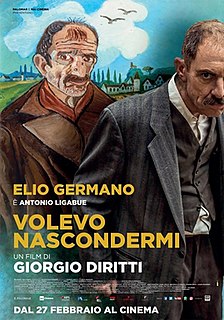
Bruno Munari was an Italian artist, designer, and inventor who contributed fundamentals to many fields of visual arts in modernism, futurism, and concrete art, and in non-visual arts with his research on games, didactic method, movement, tactile learning, kinesthetic learning, and creativity.
Farnesina may refer to:

The David di Donatello for Best Cinematography is a film award presented annually by the Accademia del Cinema Italiano to recognize outstanding efforts on the part of cinematographers who have worked within the Italian film industry during the year preceding the ceremony. The award was first given in 1981.
The David di Donatello for Best Sets and Decorations is a film award presented annually by the Accademia del Cinema Italiano to recognize outstanding efforts on the part of film set designers and decorators who have worked within the Italian film industry during the year preceding the ceremony. It was first presented during the 1981 edition of the David di Donatello award show.

The Palazzo della Farnesina is an Italian government building located between Monte Mario and the Tiber River in the Foro Italico area in Rome, Italy. Designed in 1935, it has housed the Italian Ministry of Foreign Affairs since its completion in 1959. A reference to "La Farnesina" is often to be intended as a metonymy for the hosted institution, namely the Ministry itself.
Collezione Farnesina Experimenta is a bilingual book that assembles and catalogues the eighty works of the Farnesina Experimenta Art Collection, housed in Palazzo della Farnesina.
Marco Bolognesi is an artist working in a variety of media such as drawing and painting, cinema, photo- and videography.
The 15th Rome Quadriennale or XV Rome Quadriennale is an Italian art exhibition held between 19 June and 14 September 2008 at its historical site, the Palazzo delle Esposizioni of Rome, Italy.

Fabrice de Nola is an Italian-Belgian artist born in Messina (Sicily) in 1964. He introduced the use of QR codes in oil paintings. In 2006, he created the first oil paintings containing texts and web connections to be used on mobile phones.
The 2008 Italian general election took place on 13–14 April 2008.
Paolo Consorti is an Italian artist and film director.

The art collections of Fondazione Cariplo are a gallery of artworks with a significant historical and artistic value owned by Fondazione Cariplo in Italy. It consists of 767 paintings, 116 sculptures, 51 objects and furnishings dating from the first century AD to the second half of the twentieth.
The U.S.- Italy Fulbright Commission is a bi-national, non-profit organization promoting opportunities for study, research, and teaching in Italy and the United States through competitive, merit-based grants. Since 1948, the commission acts as executor of the Fulbright Program to and from Italy.

Bruno Ceccobelli is an Italian painter and sculptor. He currently resides and works in Todi, Italy. Ceccobelli was one of the six artists of the Nuova Scuola Romana or Scuola di San Lorenzo, an artistic movement that grew out of the Arte Povera and Transavanguardia movements of the latter twentieth century.

Luca Pozzi is an Italian artist.

Hidden Away is a 2020 Italian biographical drama film co-written, directed and co-edited by Giorgio Diritti. It stars Elio Germano as Italian painter Antonio Ligabue, who lived a notoriously reclusive life, troubled with physical problems and mental illness.